We see there is no? objective defintion of soundstage, 3D-imaging and that stuff?
If there was a definitvely implemented effect that should be reproduced (or not), this would make judging easier.
My pointing to this was not well understood here, so now (did some digging) some URL for testing (there's a clear announcment what effect is to be heard; have a look at the test-files):
https://audiophilemusic.io/portfolio/jazz-sampler-audiophile-test-vol-1/
https://audiophilemusic.io/portfolio/jazz-sampler-audiophile-test-vol-2/
https://audiophilemusic.io/portfolio/jazz-sampler-audiophile-test-volume-3/
Btw not all tracks from CD are represented
If there was a definitvely implemented effect that should be reproduced (or not), this would make judging easier.
My pointing to this was not well understood here, so now (did some digging) some URL for testing (there's a clear announcment what effect is to be heard; have a look at the test-files):
https://audiophilemusic.io/portfolio/jazz-sampler-audiophile-test-vol-1/
https://audiophilemusic.io/portfolio/jazz-sampler-audiophile-test-vol-2/
https://audiophilemusic.io/portfolio/jazz-sampler-audiophile-test-volume-3/
Btw not all tracks from CD are represented

